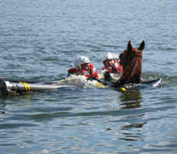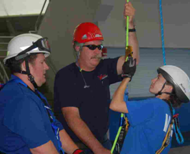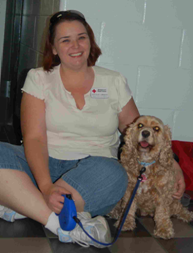
Vol. 2, No. 10, October 2006 |
 Printer-Friendly PDF Version Printer-Friendly PDF Version |
Attend The 2009 SART Conference!
 2007: Tim Manning (l) introduces Agriculture & Consumer Services Commissioner Charles Bronson
2007: Tim Manning (l) introduces Agriculture & Consumer Services Commissioner Charles Bronson
"I'm excited about the 2009 Conference," says Tim Manning, USDA/FSA, "All disasters happen at the local level, in someone's back yard.
"We are a huge and diverse state with billions of dollars of plant and animal agricultural interests, millions of companion animals that rely on us, and millions of people who need us to help safe-guard their food, their employment and the well-being of their family and friends.
"This important Conference is about building relationships between local and state or federal agencies to prepare for, respond to and recover from all disasters in the most effective possible manner. It is about fostering partnerships so that when the unexpected happens – and it does – people working in the trenches have ready knowledge of and access to resources."
The deadline to register ($80.00 fee) and reserve your room at the special conference rate of $99.00 is fast approaching.
"Home, Ranch and Farm – Working Together Works!" Expect to learn why and how at the 2009 SART Conference…barely a month away.
Conference kick-off is set for 1:00 pm Wednesday March 25th. You can also learn more about the Green Movement because this year's "gone green" conference hotel is the Holiday Inn Oceanfront Resort, Cocoa Beach www.hicocoabeachhotelsite.com.
A link to registration and the very latest information about the conference agenda is available near the top of the home page of Florida's SART web site at www.flsart.org.
[top]
Assessing “The Leon County Situation” |
Key points for Leon County. A relatively populous district surrounded by more rural, less populous counties and towns. Coastal communities evacuate to or through Tallahassee. Positive: Employees all have personal disaster preparedness plans. Needs attention: Submitted by: |
[top]
[top]
A Conference Special Note
Thursday afternoon at 3:30pm
| |||
| |||
The VET Corps is the state of Florida Reserve Corps for volunteer veterinarians and technicians. It is supported by the FVMA, the UF CVM and FDACS-AI. |
An Open Letter to SART Members |
I’m delighted with the invitation to attend the Florida SART Conference. I have always appreciated the hard work and dedication of SART members. As you know only too well, no one person or group can effectively respond to an emergency or disaster on their own: it takes everyone working together to get the job done. The theme for this year’s Florida conference Home, Ranch and Farm –Working Together Works is a very true statement. The individuals that make up each of those areas play an important role in maintaining our vital agricultural base and an even greater role when we are addressing an unknown all-hazards horizon. I realize that responding is just one of the steps, and that being ready to respond takes a great deal effort and work. SART brings all of the components together because your members are involved in the preparedness, planning and also the recovery efforts. Each of the steps require having good communications and I feel that is what a conference such as this can bring to America’s program of preparation. Coming together to exchange ideas and information is important and doing it face-to-face takes communication one step farther and makes it all that more effective. It is important that people who are going to work together spend time together in both information sharing and social environments. I feel spending this time together prepares us to work together more effectively and efficiently when an incident occurs. So thank you for the invitation. I look forward to attending the March Conference. |
[top]
Your Pre-Conference Exam |
||||||||||||||||||||||||
So, you and you team are prepared for any hazard, natural or human, eh. Here is a self-test from the Florida SART archive of Training Materials to help you make that determination. (Training materials archive www.flsart.org/library/index.htm). | ||||||||||||||||||||||||
|
Conference Preview: Pet-Friendly Evacuation Sheltering Thursday Afternoon at 2:00 pm |
||
Federal laws and supporting state legislation now require counties to accommodate pets and companion animals in emergency preparedness plans. In an era of greater governmental requirements and shrinking resources, how do we make this happen? Thursday at 2:00 pm, Florida ESF-17 coordinator Joe Kight and panel members Karan Hagan (American Red Cross, ESF-6), Emily Meyer (DEM Community Assistance Consultant) and Laura Bevan (HSUS) will lead a dynamic, open session in a frank |
||
|
[top]
Assessing and Preparing for Climate Change | ||||||||
| ||||||||
[top]
Bee College
Bee College 2009 | ||||
Speakers Special Courses, March 19th
|
[top]
AgERT Training Is Still Available |
Basic Agricultural Emergency Response Training (AgERT) provides an overview of agro-terrorism as well as chemical, biological, radiological, nuclear or explosive hazards, relative to potential impact on ag resources and the ag community. The course lasts 32 hours. Lectures include response actions, epidemiology, zoonotic and foreign animal diseases, animal restraint and euthanasia, and animal carcass disposal. Hands-on training teaches the selection and use of Personal Protective Equipment, decontamination, using survey and monitoring equipment, and preserving a crime scene. The course ends with an exercise requiring response to a hazardous event in an agricultural setting. Location: Center for Domestic Preparedness, Anniston, AL |
[top]
Wildfires: What can Florida
learn
from Australia’s fire season?
 Wildfires in Australia have killed more than 200 people and countless livestock and wild animals this month. Driven by high winds, many families were trapped and perished inside their vehicles
Wildfires in Australia have killed more than 200 people and countless livestock and wild animals this month. Driven by high winds, many families were trapped and perished inside their vehicles
Nearly 200 people have perished from wildfires sweeping southeastern Australia (and dozens died recently in Greece). This certainly gives us pause because we are approaching Florida’s own dry season and hence its spring wildfire season.
According to an Associated Press report “Many people waited too long and perished as they tried to escape the weekend infernos.” Australia’s policy has long held that individuals must make their own decisions about whether to evacuate or to stay and fight a wildfire. This policy is complicated in
many rural or far-flung suburban areas:
When confronted by the recent firestorms, almost impenetrable walls of flame, heat and smoke whipped by strong sub-hurricane-force winds, people waited until the last minute to evacuate; roads became jammed and, in the billowing smoke, accidents caused dozens of people to die in their automobiles.
Healesville, Australia’s County Fire Authority Chief Paul Rees said, “The clear evidence is that the most dangerous place to be is on the road.”
[top]
| |
|
Extension Disaster Education Network News
| |
Indiana’s EDEN members say they “can't wait” to host the annual meeting at the Sheraton Downtown in Indianapolis October 6-9, 2009. The annual meeting committee is hard at work now and while the format is not locked into place, the tentative format is to hold pre-conference training on the 6th; the program and annual meeting on the 7th and 8th; and an optional tour on the 9th. “We intend to send out the calls for proposals to present at this meeting in March 2009,” say program organizers at Purdue University. “We will post the program as soon as the proposals are in and reviewed. We hope that is by May of 2009.” In the meantime if you have comments or questions about the 2009 EDEN annual meeting call anyone on the program committee at the above link or contact Steve Cain (cain@purdue.edu) or Abigail Borron (aborron@purdue.edu) at the Purdue Extension Service. |
[top]
About the SART Sentinel |
Editor: Rick Sapp, PhD, Technical Writer, Florida Department of Agriculture & Consumer Services, Division of Animal Industry [rsa5@cox.net] Associate Editor: Joe Kight, State ESF-17 Coordinator, Florida Department of Agriculture & Consumer Services, Division of Animal Industry [kightj@doacs.state.fl.us] The SART SENTINEL is an E-mail newsletter prepared monthly by Rick Sapp and the members of the Florida State Agricultural Response Team. Past issues of the Sentinel are archived on the Florida SART Web Site, www.flsart.org. If you have a story or photo that you would like to have considered for publication in The SART SENTINEL, please contact the Editors. |
[top]
Pre-Conference Exam Answers | ||||||||||||||||||||||||
|
[top]







